Utilities Revised 11/21
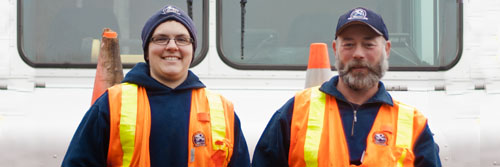
Public Works utility employees enjoying a day on the job
What Olympia Values:
Olympians value a drinking water supply that is owned and controlled by the City. We want wastewater and stormwater treated effectively before it is discharged into Puget Sound. We understand and value the role that ‘reuse, reduction and recycling’ plays in our effort to conserve energy and materials.
Our Vision for the Future:
Clean, plentiful water and significant reduction of waste.
Read more in the Community Values and Vision chapter
Introduction - Utilities Shape the Future
Olympia’s future ability to achieve long-term environmental, economic and social balance is influenced by how we deliver utility services to the community. To achieve sustainability, we’ll need to shift from a short- to a long-term focus that considers how today’s actions will affect future generations. The long-term view will emphasize reducing waste, preventing pollution, engaging the community, and managing our fiscal and environmental resources conservatively.
City utilities include Drinking Water, Wastewater, Storm and Surface Water, and Waste ReSources (garbage, organics, and recycling). Privately-owned utilities such as natural gas and electric, cable service, and telecommunications facilities are regulated locally, especially within city-owned rights-of-way. Olympia’s future will be shaped, in part, by where and when these facilities are provided.
Olympia’s utilities also provide services that protect nature and conserve resources by reducing pollution and waste, restoring habitat, and conserving water. The City is also partnering with private utilities to provide their Olympia customers with more opportunities to use renewable energy.
Most of the utility programs discussed in this chapter have adopted their own detailed master plans to guide the design and daily administration of their services. This chapter is intended to serve as a bridge between those specific plans and the broader vision of this Comprehensive Plan.
City-Owned Utilities Working Together
City-owned and operated utilities provide the community with essential services and can help shape Olympia’s future in meaningful ways. We take a coordinated, cost-effective approach to managing our utilities and fully consider the economic, social and environmental implications of all our actions.

Drinking water is provided by a City-owned utility.
Community engagement and involvement is an important component of City utility management. Customers and users help with environmental restoration projects and efforts to reduce pollution and waste. They also can participate in utility management and rate setting. A Utility Advisory Committee (UAC) appointed by City Council reviews programs, policies and rates.
The four City-owned and operated utilities include:
• Drinking Water. This utility’s mission is to provide and protect healthy drinking water for the community. This involves protecting groundwater and promoting water conservation, as well as ensuring that our drinking water meets federal Safe Drinking Water Act standards.
• Wastewater. This utility collects and conveys wastewater to treatment facilities to protect public and environmental health. It also works to reduce the number of septic systems in the City.
• Storm and Surface Water. The mission of this utility is to minimize flooding, improve water quality, and protect or enhance aquatic habitat.
• Waste ReSources. Provides collection services for residential and commercial garbage, residential recyclables and residential organics (yard debris, food waste and soiled paper), and also encourages waste reduction through educational programs. Its mission is to lead our community toward a waste-free future.
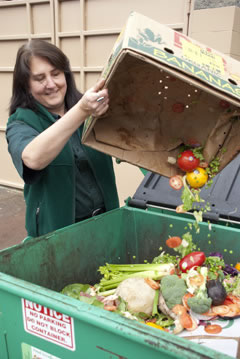
The City collects organics for composting through its Waste ReSources utility.
Over the next 20 years, there will be a growing need for us to manage our utility resources efficiently. Our challenges will include:
• Repairing and replacing aging systems. Operation and maintenance needs will continue to expand, as the pipes, pumps, valves, treatment facilities, reservoirs and wells that make up our utility system age. These needs must be met while keeping rates affordable.
• Protecting the natural environment. Water quality deterioration and habitat loss will continue to be a concern as development and utilities expand to new areas.
• Preparing for sea level rise. In addition to the flooding threat, the City’s underground utilities in the downtown area will be jeopardized.
Our utility programs will need to find partnerships and outside resources to help the City face these new challenges.
Goals and Policies
Utility and land use plans are coordinated so that utility services can be provided and maintained for proposed future land uses.
PU1.1Require annexation of all properties for which new City wastewater or drinking water services are requested if the property is outside the City, but inside the Urban Growth Area. Or, require property owners to sign a Binding Agreement to Annex when requested by the City.
PU1.2Require new developments to construct drinking water, wastewater and stormwater utilities in ways that meet the community development, environmental protection, and resource protection goals of this Plan, and that are consistent with adopted utility plans and extension policies.
PU1.3Evaluate land use plans and utility goals periodically to ensure growth is guided by our knowledge of current environmental constraints and the latest available utility technology.
PU1.4Make necessary improvements to utility facilities that do not currently meet minimum standards. Prioritize capital improvements to existing systems based on age, condition, risk of failure, and capacity.
PU1.5Ensure that public utility and transportation-related facilities constructed in Olympia and its Growth Area meet City standards for safety, constructability, durability and maintainability. (See City of Olympia Engineering Design and Development Standards.)
PU1.6Annually update the utility portions of the Capital Facilities Plan to reevaluate infrastructure priorities.
Reliable utility service is provided at the lowest reasonable cost, consistent with the City’s aims of environmental stewardship, social equity, economic development and the protection of public health.
PU2.1Ensure that new development projects pay for their own utility infrastructure based on their expected needs for the next 20 years. Also require them to contribute to their portion of existing infrastructure. Routinely review new-development charges (such as general facility charges) when updating utility master plans, or more frequently as needed.
PU2.2Ensure that utility fees, such as rates and general facility charges, are structured to reasonably reflect the actual cost of providing services to each customer class. Fees must also encourage customers to conserve water and reduce their demand on our wastewater treatment system.
PU2.3Provide special rates for low-income senior and low-income, disabled utility customers.
PU2.4Ensure that adequate funds are generated by the City’s utilities to maintain utility services and capital improvement programs.
PU2.5Use fiscally responsible management practices in order to maintain favorable bond ratings for the City’s utilities.
PU2.6Provide service to existing and new customers consistent with the legal obligation of City utilities to provide service.
PU2.7Use pricing to encourage utility customers to reduce waste, recycle, conserve water, and help protect our surface water quality.
PU2.8Use debt financing responsibly to support needed capital facility investments and "smooth" rate impacts.
PU2.9Use Developer Reimbursement Agreements that include "latecomer fees" and similar tools to enable property owners to recover some of the initial costs of extending infrastructure to serve their developments, when others connect to such extensions at a later date.
PU2.10Consider the social, economic and environmental impacts of utility repairs, replacements and upgrades.
PU3.1Coordinate public utility functions (such as operations and maintenance, public education and outreach, and Capital Facilities planning) for drinking water, wastewater, storm and surface water, and waste resources.
PU3.2Regularly revise the Olympia Municipal Code and Engineering Development and Design Standards to give detailed guidance on how utility services should be delivered and paid for in accordance with the principles established in this Comprehensive Plan.
PU3.3Update all utility master plans regularly and in accordance with state law.
PU3.4Coordinate long-term planning and scheduling of utility capital improvements with neighboring jurisdictions and other local agencies, such as LOTT.
PU3.5Work with neighboring jurisdictions to provide regionally coordinated utility systems for urban services that benefit from a regional approach.
PU3.6Locate public and private utilities in public rights-of-way and/or easements on private property in a manner to facilitate safe and efficient operation, maintenance and repair, and to minimize conflicts. Provide guidance within the Engineering Design and Development Standards that shows how and where public and private utilities should be located, including opportunities for co-location.
PU3.7Evaluate programs for effectiveness and efficiency on a regular basis.
PU3.8Contribute a portion of utility revenue each year to educational programs for schools, neighborhoods and community organizations to help meet utility goals.
PU3.9Ensure consistent maintenance, asset management, and emergency management practices for all utilities.
Use Olympia’s water resources efficiently to meet the needs of the community, reduce demand on facilities, and protect the natural environment.
PU4.1Encourage and allow re-use techniques, including rainwater collection, greywater systems, and use of Class A reclaimed water as alternatives to use of potable water, in order to enhance stream flows or recharge aquifers, while also protecting water quality.
PU4.2Develop specific targets for reducing potable water use.
PU4.3Raise community awareness about why and how to conserve water.
PU4.4Reduce water system leakage as much as possible, at a minimum below the Washington State limit of 10 percent of total water production.
PU4.5Model best practices in our City operations and the Olympia Municipal Code.
PU4.6Advance the use of reclaimed water as defined in Council-adopted policies.
Drinking Water on Tap
Olympians recognize that the water they use comes from groundwater supplies that need to remain plentiful and unpolluted by our “above-ground” activities. The City’s Drinking Water Utility aims not only to preserve the supply of this resource, but to keep it clean – both for us and for the plants, fish and wildlife that also depend on it.
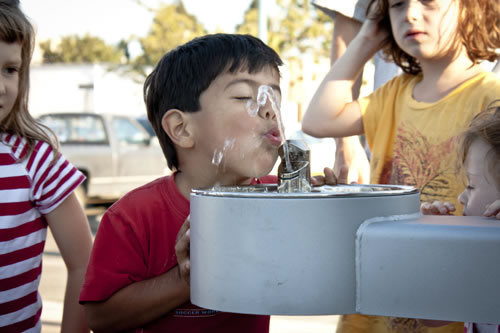
A young Olympian drinks from a new water fountain at Percival Landing.
Every day, the City of Olympia delivers affordable, high-quality drinking water to nearly 55,000 people through about 19,000 connections. This water consistently meets 100% of U.S. Environmental Protection Agency standards for safe drinking water, and it is pumped to our homes at a fraction of the cost some will pay for unregulated bottled water.
The City also provides transmission and distribution of Class A Reclaimed water to customers in a limited area of downtown Olympia.
Olympia’s Drinking Water Utility operates under a permit granted by the Washington State Department of Health‘s Office of Drinking Water. Information about the City’s Drinking Water Utility can be found in Olympia’s Water System Plan.
In the next 20 years, the Utility will face these challenges and issues:
• Changing water quality regulations. The Utility must be ready to respond to any changes in water quality regulations and treatment requirements imposed by state and federal agencies.
• Keeping pace with development. Fast or slow, the rate of growth will determine how new water sources are developed and when they come on line.
• Protecting groundwater from contamination. Risks to groundwater will increase as the population increases, and will require the City to regularly evaluate, monitor, and take action to control sources of pollution.
Goals and Policies
Adequate supplies of clean drinking water are available for current and future generations and instream flows and aquifer capacity are protected.
PU5.1Reserve water supply rights for at least 50 years in advance of need, so that supplies can be protected from contamination and they are not committed to lower priority uses.
PU5.2Develop and maintain multiple, geographically-dispersed sources of water supply to increase the reliability of the system.
PU5.3Monitor water levels in aquifers and maintain numerical groundwater models.
PU5.4Coordinate with Lacey, Tumwater, Thurston County and Public Utility District #1 to assure adequate water supplies throughout the City’s Water Service Area, following the provisions of the Growth Management Act, Public Water System Coordination Act, and the Municipal Water Law.
PU5.5When practical, develop regionally consistent Critical Areas Ordinance regulations, Drainage Manual requirements, and other policies to ensure we are protecting groundwater quantity and quality across jurisdictional boundaries.
Groundwater in the City’s Drinking Water (Wellhead) Protection Areas is protected from contamination so that it does not require additional treatment.
PU6.1Monitor groundwater quality to detect contamination, evaluate pollution reduction efforts, and to understand risks to groundwater.
PU6.2Implement programs to change behaviors that threaten groundwater quality, and that raise awareness about aquifers and the need for groundwater protection.
PU6.3Prevent groundwater contamination in Drinking Water Protection Areas by developing and implementing spill prevention and response plans.
PU6.4Maintain the City’s Critical Areas Ordinance, policies, development review process and program management, to ensure we protect groundwater quality and quantity.
PU6.5Maintain a contaminant-source inventory that identifies priority pollutants for each water source within Drinking Water (wellhead) Protection Areas, and update them regularly.
The drinking water system is reliable and is operated and maintained so that high quality drinking water is delivered to customers.
PU7.1Maintain and update the Water System Plan, Engineering Design and Development Standards and Olympia Municipal Code to ensure drinking water utility facilities meet the requirements of the Growth Management Act, North Thurston County Coordinated Water System Plan, Washington Department of Health and Olympia Fire Code.
PU7.2Maintain 100 percent compliance with all state and federal requirements, and continually improve our water quality management program.
PU7.3Design Olympia’s water supply system to achieve the most favorable and practical fire insurance rating, consistent with adopted service levels.
PU7.4Continue and improve maintenance management, including preventive maintenance, repairs and replacements.
PU7.5Prepare for and respond to emergencies and maintain secure facilities.
PU7.6Continue to improve operations and maintenance program management, including safety, asset management and meter replacement.
PU7.7Develop and maintain adequate storage, transmission and distribution facilities.
PU7.8Require private water purveyors that build new systems within Olympia’s water service area to build to Olympia’s standards so the systems can be integrated in the future.
Managing Wastewater Effectively
The purpose of Olympia’s Wastewater Utility is to protect public and environmental health by ensuring that wastewater is collected and conveyed to treatment and disposal facilities with minimal risk.
Olympia provides wastewater collection service to 17.5 square miles of the City and about eight square miles of Urban Growth Area in unincorporated Thurston County. However, many neighborhoods and individual lots within the City are still using septic systems. By 2035, Olympia expects public sewers will be extended to serve most of the Urban Growth Area.
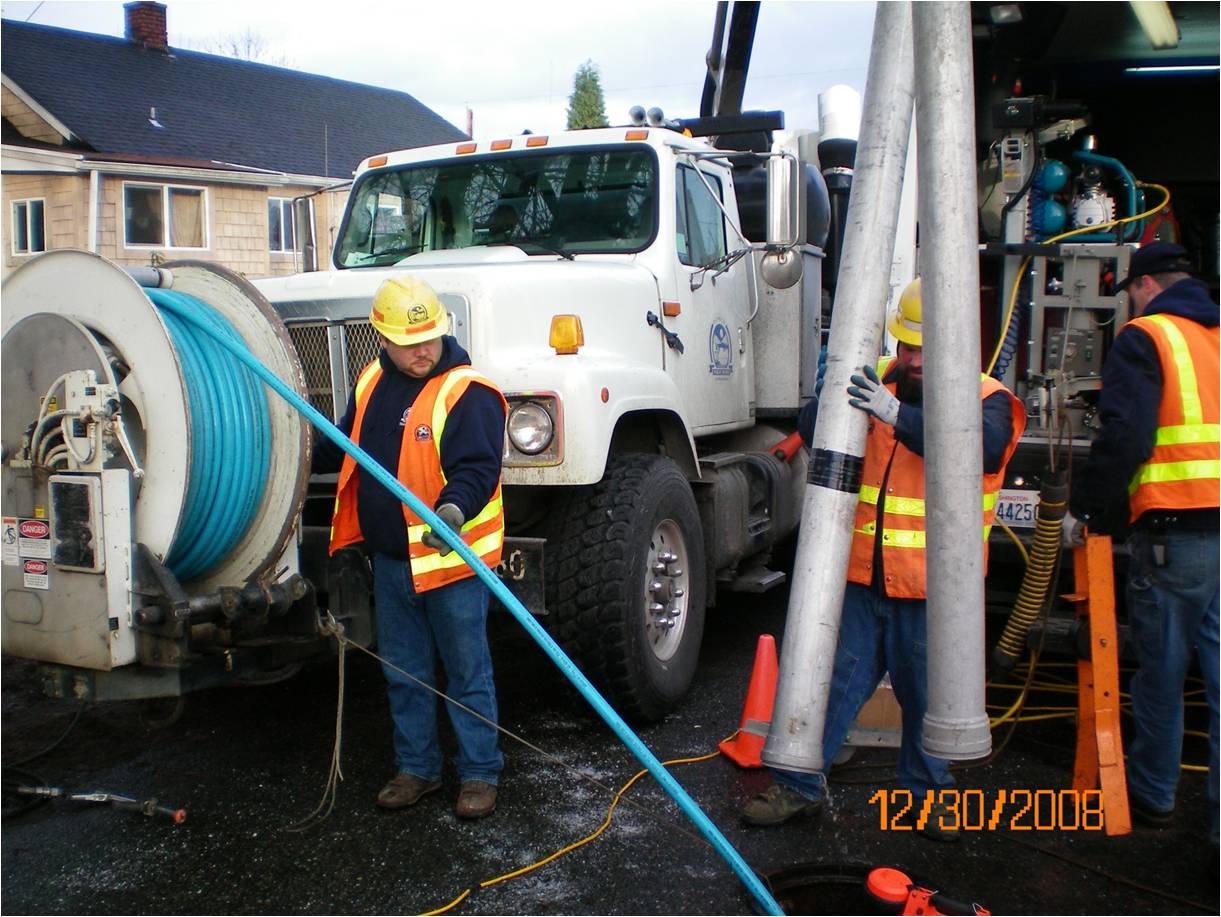
Olympia crew members maintaining the sewer system to ensure proper functioning.
All wastewater collected by Olympia is conveyed to LOTT-owned transmission mains and treatment facilities for treatment and disposal. Treatment and disposal is managed by the LOTT Clean Water Alliance, which is a partnership of the cities of Lacey, Olympia, Tumwater and Thurston County.
Wastewater Utility activities are guided by the Wastewater Management Plan. The LOTT Clean Water Alliance developed and actively manages its own Plan, known as the Wastewater Resource Management Plan, which it updates every year. The Plan addresses the treatment and disposal needs for all of its partners.
The Wastewater Utility coordinates a number of activities with the LOTT Clean Water Alliance, including maintenance, condition assessments, and pre-treatment program efforts. These activities are all required under the National Pollution Discharge Elimination System (NPDES) Permit, which covers both the City’s wastewater collection system and LOTT-owned facilities. This shared responsibility requires continuous communication between the two entities, at both the operation and planning levels.
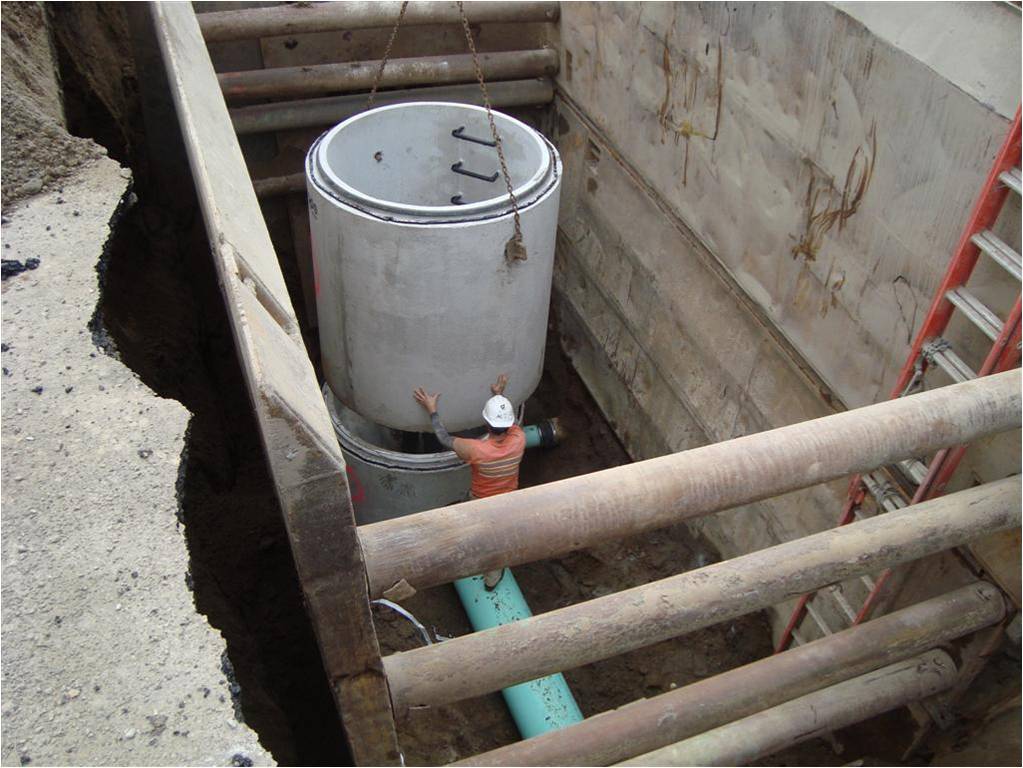
Installing a deep sewer manhole on Henderson Boulevard as part of a planned capital improvement project.
The Wastewater Utility faces the following key challenges over the next 20 years:
• Maintaining existing infrastructure. More than half of the City’s wastewater infrastructure has passed its design life or is susceptible to corrosion. Given the need to protect public health, repair and replacement of failing sewer systems typically cannot be deferred.
• Reducing septic systems. Many septic systems, especially in older parts of the City, are beyond or approaching their design life. This presents the potential for failure and risk to public and environmental health.
Goals and Policies
The City and its growth area are served by a City-owned wastewater collection and transmission system that is designed to minimize leakage, overflows, infiltration and inflows so as to provide sufficient capacity for projected demand.
PU8.1Extend the wastewater gravity collection system through both public and private development projects.
PU8.2Prohibit new community and individual septic systems within City limits, except when specifically allowed by the Olympia Municipal Code.
PU8.3Limit and ultimately phase-out community septic systems in the Urban Growth Area.
PU8.4Encourage septic system owners to connect to the City wastewater system by offering incentives, cost-recovery mechanisms, pipe extensions and other tools.
PU8.5Permit new STEP systems only for individual lots in neighborhoods currently served by STEP systems.
PU8.6Require the conversion of septic systems to the City-owned wastewater collection system upon septic system failure or building use change, whenever feasible.
PU8.7Separate combined wastewater/stormwater pipes in conjunction with stormwater and road improvements or residential repairs, when economically feasible.
PU8.8Evaluate the structural integrity of aging wastewater facilities and repair and maintain as needed.
PU9.1Allow conditional use of alternative systems, such as composting toilets and greywater systems when potential benefits are clear and there is not risk to public or environmental health.
Rainfall, Runoff, and Surface Water
The mission of the Storm and Surface Water Utility is to provide services that minimize flooding, maintain or improve water quality, and protect or enhance aquatic habitat. The goals and policies that protect water quality and aquatic habitat are located in the Natural Environment chapter. This Utility works on reconciling conflicts between protecting our ‘built’ landscape from flooding and conservation of our water quality and aquatic habitat.
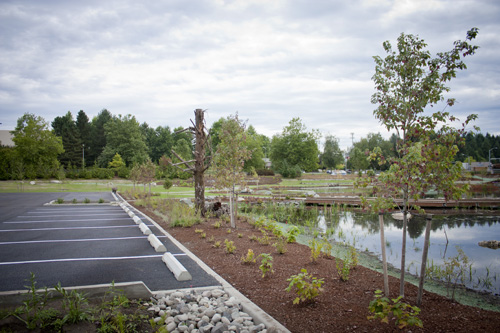
Porous pavement, bioretention and constructed wetlands demonstrate stormwater options for low impact development at Yauger Park.
The Storm and Surface Water Utility maintains more than 130 miles of underground pipe, more than 7,000 storm drains, and 95 stormwater ponds that filter stormwater runoff from roads and rooftops before it reaches our streams and Budd Inlet. The "surface water" for which Olympia’s Storm and Surface Water Utility shares responsibility includes nine streams within the City, four lakes, four large wetlands, and about six miles of marine shoreline.
The Stormwater Utility is guided by the Storm and Surface Water Plan which outlines its challenges, goals, implementation tools and financial implications. Increasingly, this Utility is affected by state and federal regulatory requirements such as the Western Washington Phase II Municipal Stormwater Permit.
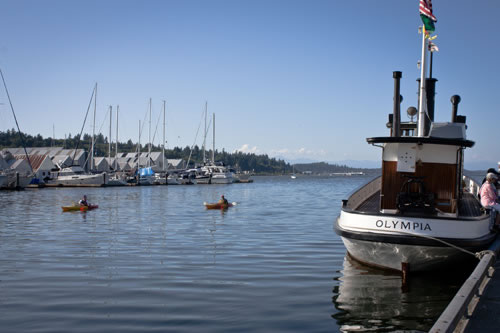
Kayakers in Budd Inlet as seen from Percival Landing.
Olympia’s growth and urbanization have placed increasing demands on our natural systems. Major challenges facing the Storm and Surface Water Utility in upcoming years include:
• Managing the impact of increasing stormwater runoff. The cumulative impact of paving and development will increase pollutants in streams and Puget Sound, decrease infiltration to groundwater, and reduce forest habitat.
• Preparing for sea level rise. We will need a coordinated effort to protect our downtown from the flooding that could result from a sea rise scenario of 50 inches by 2100.
• Keeping up with new technology. As innovative approaches to treating and controlling stormwater rapidly evolve, the Storm and Surface Water Utility must evaluate the effectiveness and long-term implications of new technologies, while also managing risks associated with potential failures.
Goals and Policies
The frequency and severity of flooding are reduced and hazards are eliminated, except during major storm events.
PU10.1Improve stormwater systems in areas that are vulnerable to flooding.
PU10.2Emphasize the importance of emergency preparedness.
PU10.3Evaluate the structural integrity of aging stormwater pipes and repair as needed.
PU10.4Inspect private and public stormwater systems to identify required maintenance and repairs.
PU10.5Inventory and inspect City-owned culverts and ditches and perform maintenance if needed.
PU10.6Ensure that private pipe and pond systems are maintained.
The City uses best available information to implement a sea level rise management plan that will protect Olympia’s downtown.
PU11.1Evaluate different scenarios for sea level rise, including varying magnitudes and time horizons, and develop a progression of adaptation and response actions for each scenario.
PU11.2Develop plans, cost estimates and financing options for addressing sea level rise that include regulatory, engineering and environmentally sensitive solutions.
PU11.3Maintain public control of downtown shorelines that may eventually be needed to help manage flood water.
PU11.4Incorporate sea level rise planning into the design of public and private infrastructure where needed.
PU11.5Use the best available science and the experiences of other communities in formulating plans for sea level rise.
PU11.6Partner with government entities and other key stakeholders, such as, the federal government, State of Washington, LOTT Clean Water Alliance, Port of Olympia, Squaxin Island Tribe, downtown property owners, businesses and residents, environmental groups, and other interested parties.
PU11.7Engage the community in a discussion of various sea level rise scenarios, how the City will respond to lessen the impact, and what the costs would be.
PU11.8Require development to incorporate measures, such as higher finished floor elevations, that will reduce risks and avoid future costs associated with rising sea levels; and to encourage acknowledgment of such risks by state and federal agencies.
Towards Zero Waste
Waste is an expanding global problem caused by a growing population and increasing consumption. Our national economy is based on extracting resources, manufacturing and distributing products; a system that encourages excessive waste and does not take into account the full environmental and social costs of this activity. The result is increasing depletion of natural resources, increasing greenhouse gas emissions, and deteriorating air and water pollution - all of which are environmentally unsustainable and costly to society.
The amount of waste collected per person each day in Olympia coupled with an increasing population, puts pressure on our already strained regional waste management system. Olympians can help solve these problems through a variety of regional and local actions that seek to reduce the amount of waste generated, and increase the amount recycled and recovered for reuse.
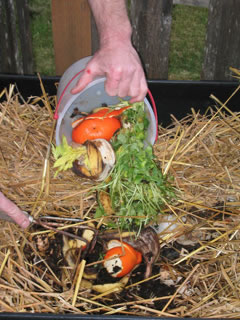
Compost at home to reduce waste.
Olympia’s Waste ReSources Utility is responsible for ensuring that all of the City’s waste is properly managed, and is directly responsible for providing collection services for residential and commercial garbage, residential recyclables and residential organics.
In June 2006, the Olympia City Council adopted a Zero Waste Resolution, which established a vision for the City and a new direction for the Waste ReSources Utility. This resolution gave rise to a new strategic and operational six-year plan - Olympia’s Waste ReSources Plan - , which focuses on a Zero Waste approach. In fact, Olympia’s Olympia’s Waste ReSources Plan anticipates a future in which "waste" is viewed as an inefficient use of resources. The Plan is regularly updated.
In the next 20 years, the utility will face the following challenges and opportunities:
• Reduce sources of waste. The whole life cycle of a product must be considered as we find ways to reduce waste in both "upstream" production and distribution processes and "downstream" consumer choices and waste management practices.
• Respond to an ever-evolving waste stream. Continue adapting to changes in packaging, markets, and product recyclability.
• Optimize the current collection system. Continue to increase the portion of waste that is recycled or composted, while maintaining efficient operations.
• Maximize commercial recycling. Continue to evaluate the potential for City-provided commercial recycling services.
Goals and Policies
PU12.1Reduce waste and encourage recycling through the City’s purchasing, recycling and disposal policies.
PU12.2Follow the solid waste management hierarchy established in federal and state legislation, which sets waste reduction as the highest priority management option, followed by reuse, recycling and responsible disposal.
PU12.3Expand, when practical and feasible, the City’s recycling, composting and waste reduction programs to maximize the diversion of material from disposal into remanufacture and reuse.
PU12.4Support the goals and policies of the Thurston County Solid Waste Management Plan.
PU13.1Encourage and promote waste reduction and recycling.
PU13.2Manage waste locally to reduce transfer and disposal costs.
PU13.3Explore new methods of reducing, reusing, recycling and disposing of solid wastes.
PU13.4Use technology to create and maintain efficient and effective routing and collection programs.
PU13.5Develop specific targets for waste reduction in Olympia in utility master plans.
PU14.1Handle and dispose of solid waste in ways that minimize land, air and water pollution and protect public health.
PU14.2Work cooperatively with Thurston County to ensure that the operations of the Thurston County Waste and Recovery Center (WARC) are in compliance with state and federal regulations, and are responsibly managed.
Coordination with Private Utilities
Most private utilities are regulated at the state level by the Washington Utilities and Transportation Commission (WUTC), which ensures that customers receive safe and reliable service at reasonable rates. The Commission regulates the rates and charges, services, facilities and practices of most of Washington’s investor-owned gas, electric and telecommunication utilities.
Growth in residential, commercial, or industrial development often requires expanded utility services. Because of this, City land use decisions that affect both density and the location of new development will drive new private utility needs.
In Olympia, private utilities provide these services:
• Electricity: Puget Sound Energy (PSE) is the only provider of electricity to Olympia and its Urban Growth Area. PSE is an investor-owned utility providing electricity to nine western and central Washington counties.
• Natural Gas: PSE is also the only natural gas provider to Olympia and its Urban Growth Area. PSE serves natural gas customers in six western and central Washington counties.
• Standard Telephone Service: The only provider of standard telephone service in Olympia and its Urban Growth Area is CenturyLink Communications International, Inc. (CenturyLink). CenturyLink is an investor-owned corporation offering local telecommunication services to customers in 14 states. It also provides broadband data and voice (including long-distance) communications services outside their local service area, as well as globally.
• Telecommunications and Cellular Telephone Service: Many new telecommunication providers have entered the market and offer options that have created a very competitive environment. These factors make it difficult to accurately assess how future telecommunications will be provided.
• Cable Services and Programming: Comcast is the only cable provider serving Olympia. Properties that lie within the UGA are covered under Thurston County’s franchise. Currently, cable companies are not regulated by the state, but by local governments and the FCC. Comcast has a 10-year non-exclusive franchise agreement to use public right-of-way to provide cable services within the Olympia city limits. This agreement was adopted by the City Council in 2009.
Goals and Policies
PU15.1Coordinate utility planning activities with the private utility providers. The City will work with the private utilities to achieve consistency between their facility plans and the City’s regulations and long-range plans.
PU15.2Share information, when requested, with private utilities on current and projected figures for population, employment, development, and utility service demand.
PU15.3Process permits and approvals for private utility facilities in a fair and timely manner, and in accordance with development regulations that foster predictability.
PU15.4Ask for input from the private utilities when developing policies that will affect their service and activities, such as street excavation, street obstructions, and fees.
PU15.5Maintain agreements, where appropriate, with private utilities, updating them as needed to adapt to changing needs and plans.
PU15.6Olympia and Thurston County will coordinate with each other and with the cities of Lacey and Tumwater to create consistent utility regulations and long-range plans that promote efficient and effective utility services.
PU15.7Olympia and Thurston County will coordinate with each other and with the cities of Lacey and Tumwater when private, multijurisdictional utility additions and improvements are being planned.
PU15.8Regarding private utility facilities, make decisions that are consistent and complementary to regional demand and resources and that reinforce an interconnected regional distribution network.
PU15.9Olympia and Thurston County will coordinate with each other and the cities of Lacey and Tumwater on emergency management related to utility services by following the Natural Hazards Mitigation Plan for the Thurston Region.
Private utilities are located underground to protect public health, safety and welfare, and to create a more reliable utility system.
PU16.1Place new private utility distribution lines underground wherever practicable. This should be based on sound engineering judgment, on consideration of health and safety, and in accordance with the regulations and tariffs of the Washington Utilities Transportation Commission and the City’s Engineering Development and Design Standards.
PU16.2Encourage placing existing private utility distribution lines underground, in accordance with the regulations and tariffs of the Washington Utilities Transportation Commission and the City’s Engineering Development and Design Standards.
PU16.3Coordinate the undergrounding of both new and existing private utility lines consistent with policies PU 3.1 and PU 3.2.
PU16.4Apply utility undergrounding requirements to all private development projects.
PU16.5Develop and maintain a management plan, consistent with the Olympia Municipal Code and the Engineering Development and Design Standards, for underground and overhead utilities as part of the City’s franchise agreements. The management plan also must address undergrounding of the City’s aerial facilities, as well as other franchise utilities. (See OMC telecommunications Chapter 11 regarding permitting and leasing)
PU17.1Promote the co-location of new utility distribution and communication facilities when doing so is consistent with utility industry practices and national electrical and other codes. (See policy PU3.6 that recommends a guidance drawing showing utility locations.)
PU17.2Give private utilities timely notice when road construction is planned, to coordinate utility trenching work.
Adverse impacts of above-ground utility facilities such as sub stations and cellular towers on surrounding land uses are minimized.
PU18.1Locate private utility facilities near compatible adjacent land uses. City regulations will specify that approval of new private utility facilities shall be reasonably compatible with the development of the surrounding properties.
PU18.2Ensure that the City’s zoning code includes standards that ensure that new private utility facilities are coordinated and integrated with surrounding land uses so they are reasonably compatible with the natural and built environment. These regulatory standards should also support facility design which minimizes the visual intrusion of facilities in all areas.
PU18.3Encourage telecommunication utilities to use existing structures, such as existing towers and buildings, where a new installation will not conflict with height restrictions.
Every resident and business in Olympia has access to affordable cable television and Internet services.
PU19.1Encourage cable services to incorporate their latest features and improvements for their Olympia-area customers as they become technologically and economically feasible.
PU19.2Seek to ensure that any cable franchisee serving the Olympia area provides a high quality of customer service, signal transmission, and programming variety.
PU20.1Ensure cable service to major public buildings allows programs to originate there, as well as to be received there.
Public educational institutions and governments can air programming on designated channels on the cable system.
PU21.1Ensure that cable service includes no fewer than four local access channels, which are responsibly and fairly administered in the public interest.
The City should make provisions in its policies, regulations and Engineering Development and Design Standards for a fiber optic conduit system as part of its municipal infrastructure.
Appendix A: Utilities Inventory and Future Needs
City-Owned Utilities
Drinking Water
Inventory
A network of springs, wells, pumps, reservoirs and transmission lines supplies water to Olympia’s customers. McAllister Springs provides the majority of drinking water for the City. McAllister Springs is unfiltered surface water and therefore subject to more stringent treatment requirements. A 36-inch transmission main moves water from the springs (and the new wellfield) to the Meridian reservoirs, and then on a nine-mile journey into reservoirs at Fir Street. From there, it is pumped and piped throughout the City. The rest of the City’s drinking water is provided by six wells (two wells at Allison Springs, and one each at Kaiser, Indian Summer, Shana Park, and Hoffman). The map below shows the major components of Olympia’s water system.
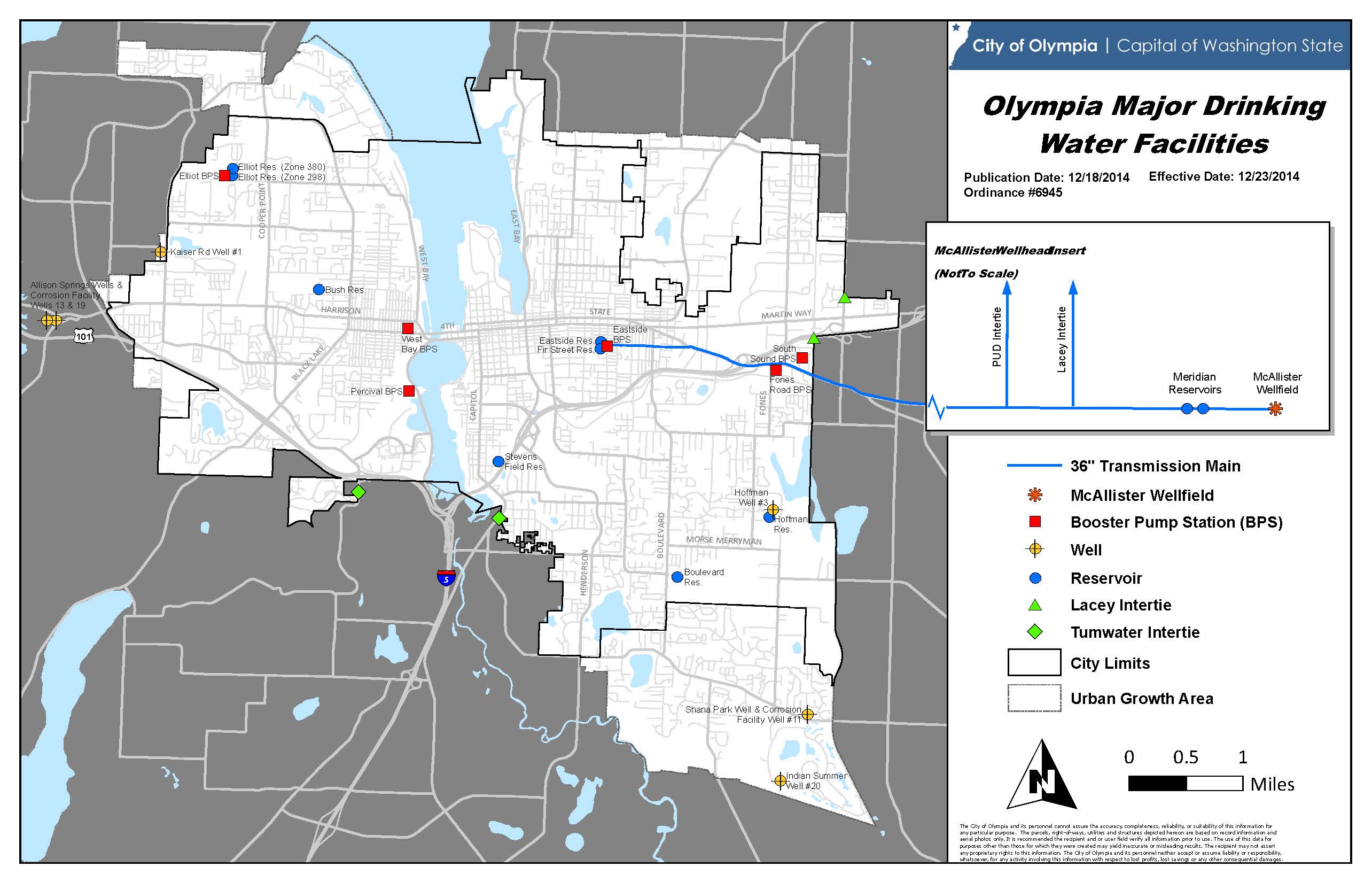
Olympia Major Drinking Water Facilities
Class A reclaimed water treatment, production and main distribution facilities are jointly owned and operated by the Lacey, Olympia, Tumwater and Thurston County (LOTT) CleanWater Alliance. Olympia owns and operates a limited distribution system for reclaimed water in the downtown area. Olympia and LOTT Major Reclaimed Water Facilities map shows the major components of both the City’s and LOTT’s reclaimed water system.
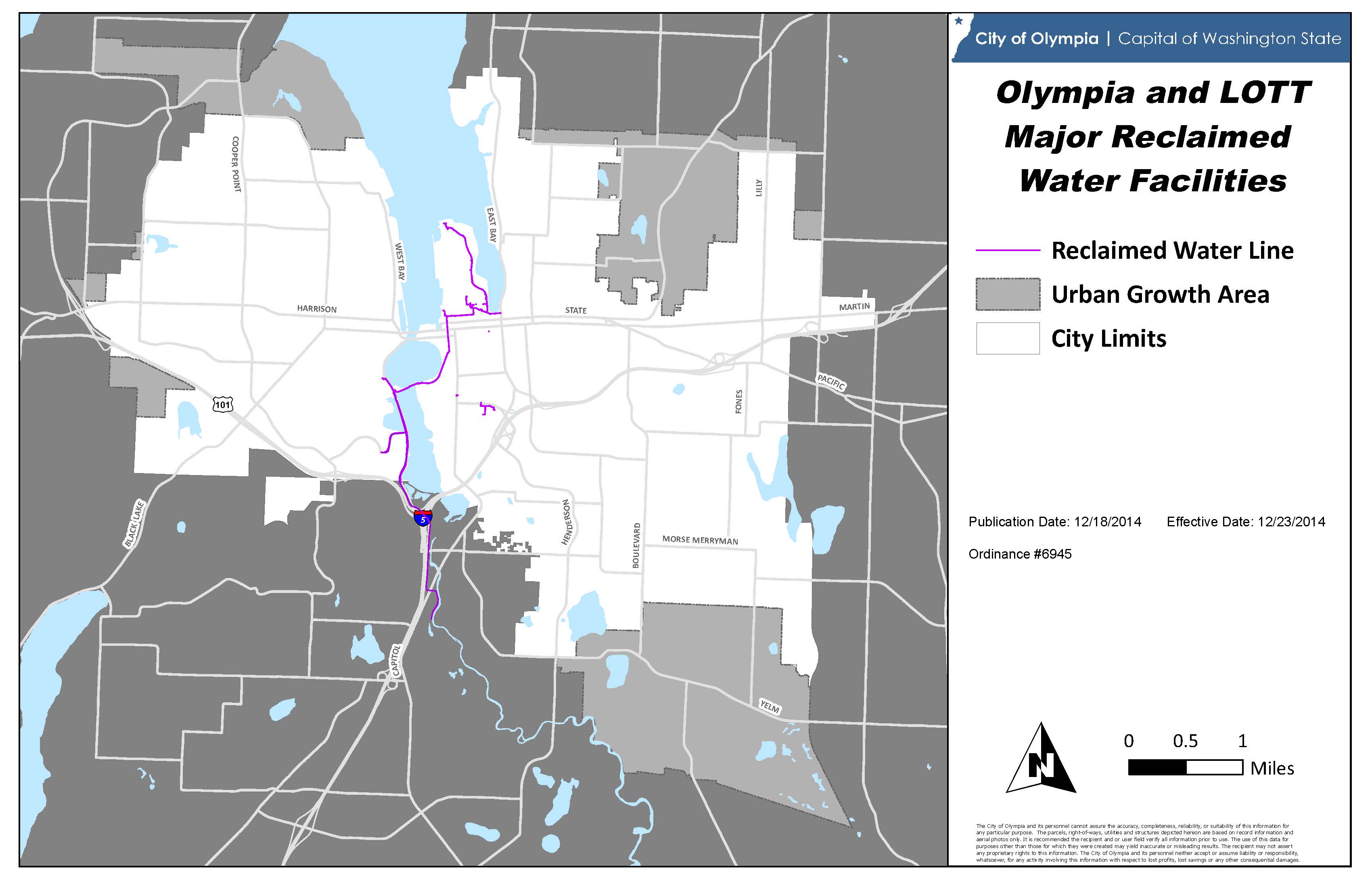
Olympia and LOTT Major Reclaimed Water Facilities
Existing Capacity
Olympia’s water service area boundary map generally follows the Urban Growth Area. Policies related to providing service to this area are defined in Washington’s Municipal Water Law, the North Thurston County Coordinated Water System Plan, and Olympia’s Water System Plan and municipal code. Olympia has adequate water rights reserved to supply customers within the service area for a minimum of 50 years. Conservation and reclaimed water programs will also help extend Olympia’s water supply.
Eleven storage tanks serve seven pressure zones throughout the City, with a total capacity of 30.88 million gallons. Five are steel and six are concrete. The Meridian Storage Tanks, located west of McAllister Springs, provide 8 million gallons of storage. The transmission and distribution system is a network of 275 miles of pipe, ranging from ¾-inch to 36 inches in diameter and ranging in age from new to nearly 80 years old. The pipes are made of various materials, including galvanized steel, polyvinyl chloride (PVC), asbestos cement, concrete, ductile iron, steel, high-density polyethylene and plastic. The City is divided into seven water pressure zones for distribution throughout the service area.
Future Facilities
Future needs for drinking water will be met by:
• Developing new water sources.
• Repairing and replacing deteriorating pipes, pumps and reservoirs.
• Developing new transmission, distribution and storage facilities to serve the growing community.
The City is in the final steps of relocating the withdrawal point of its main water source to a new wellfield near McAllister Springs, which will be a more protected and productive supply source. New sources will provide additional system reliability as geographically dispersed sources of water in the future. A new reservoir in southeast Olympia will also be required.
General facilities charges, which are paid by developers, will fund growth-related improvements. Other improvements will be financed through utility rates, often using bonds and low interest loans. The City is also jointly developing a reclaimed water infiltration facility with the City of Lacey for water supply mitigation purposes, outside the City’s service area.
Wastewater
Inventory
Within Olympia and its Urban Growth Area, the wastewater system consists of nearly 200 miles of gravity pipes, 30 pump stations and 1,800 STEP systems owned and maintained by the City. There are 4,200 privately owned and maintained septic systems, and regional collection and treatment facilities owned by the LOTT Alliance. Major infrastructure components are shown on the Wastewater Major Facilities and Assets map below. The way the wastewater system is planned and managed has a major impact on the City’s ability to accomplish its land use, environmental, economic development, and growth-management goals.
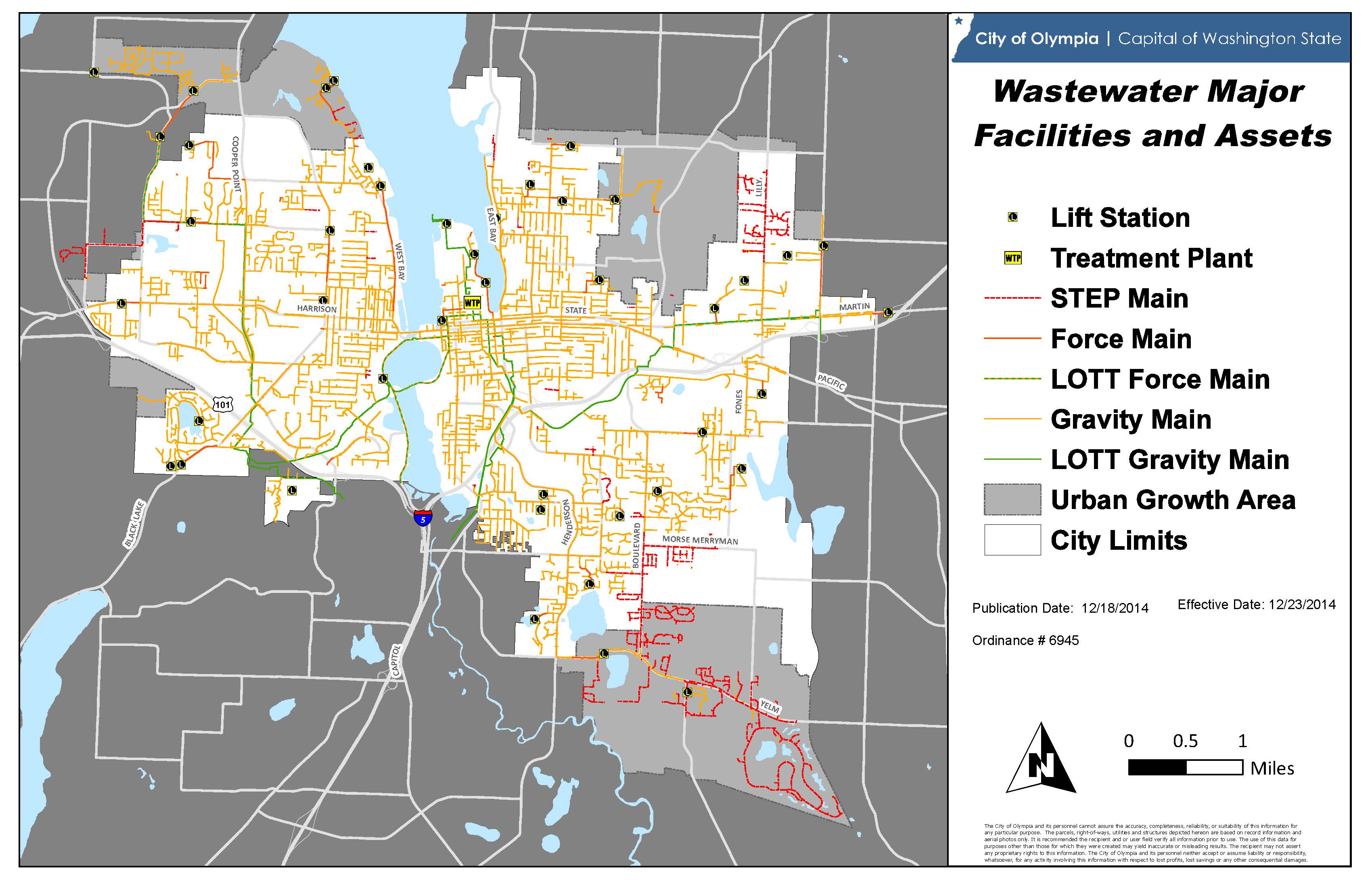
Wastewater Major Facilities and Assets map
Existing Capacity
Generation rates refer to the amount of wastewater produced by an average customer on a typical day. The Olympia-derived base flow (estimated at approximately 4.2 million gallons per day (MGD)) was divided by the 2006 service population to arrive at the following profile.
• Residents: 63 gallons-per-capita per day, or 170 gallons per-day per Equivalent Residential Unit (ERU).
• Employees: 27 gallons-per-employee per day.
Using these values, the base wastewater generated within the City of Olympia is projected to increase from 4.2 MGD to 7.2 MGD by 2025.
Future Facilities
Computer analysis indicates that, in general, the City’s wastewater system has few existing and potential future capacity limitations as long as future flows are carefully routed to appropriate regional collector pipes. Planning for and directing these future flows is a key strategy for optimizing system capacity. Using computer flow simulations, Wastewater Utility staff monitors and manages existing and future flows, tracks the need for long-term improvements, and plans for future construction projects before reaching capacity. The LOTT Clean Water Alliance Wastewater Resource Management Plan addresses future capacity and treatment upgrades to the regional system.
When infrastructure improvements are needed due to new development, future users of the new facilities repay the City through general facilities charges, latecomer fees or other potential cost recovery tools.
The Capital Improvement Program to meet forecasted 6- to 20-year needs is included in the Wastewater Management Plan, and revised and updated in the City’s most recently adopted Capital Facilities Plan.
Storm and Surface Water Utility
Inventory
The Utility maintains more than 130 miles of underground pipe, more than 7,000 storm drains, and 95 stormwater ponds that carry storm water runoff from roads and rooftops to our streams and Budd Inlet. The Storm and Surface Water map shows the location of the City’s major storm and surface water facilities. In addition to Olympia’s public stormwater infrastructure, the Utility provides technical assistance and performs maintenance inspections on privately-owned stormwater systems throughout the City. A variety of small areas are still served by a combined sanitary/stormwater sewer, which routes flows to the LOTT treatment plant.
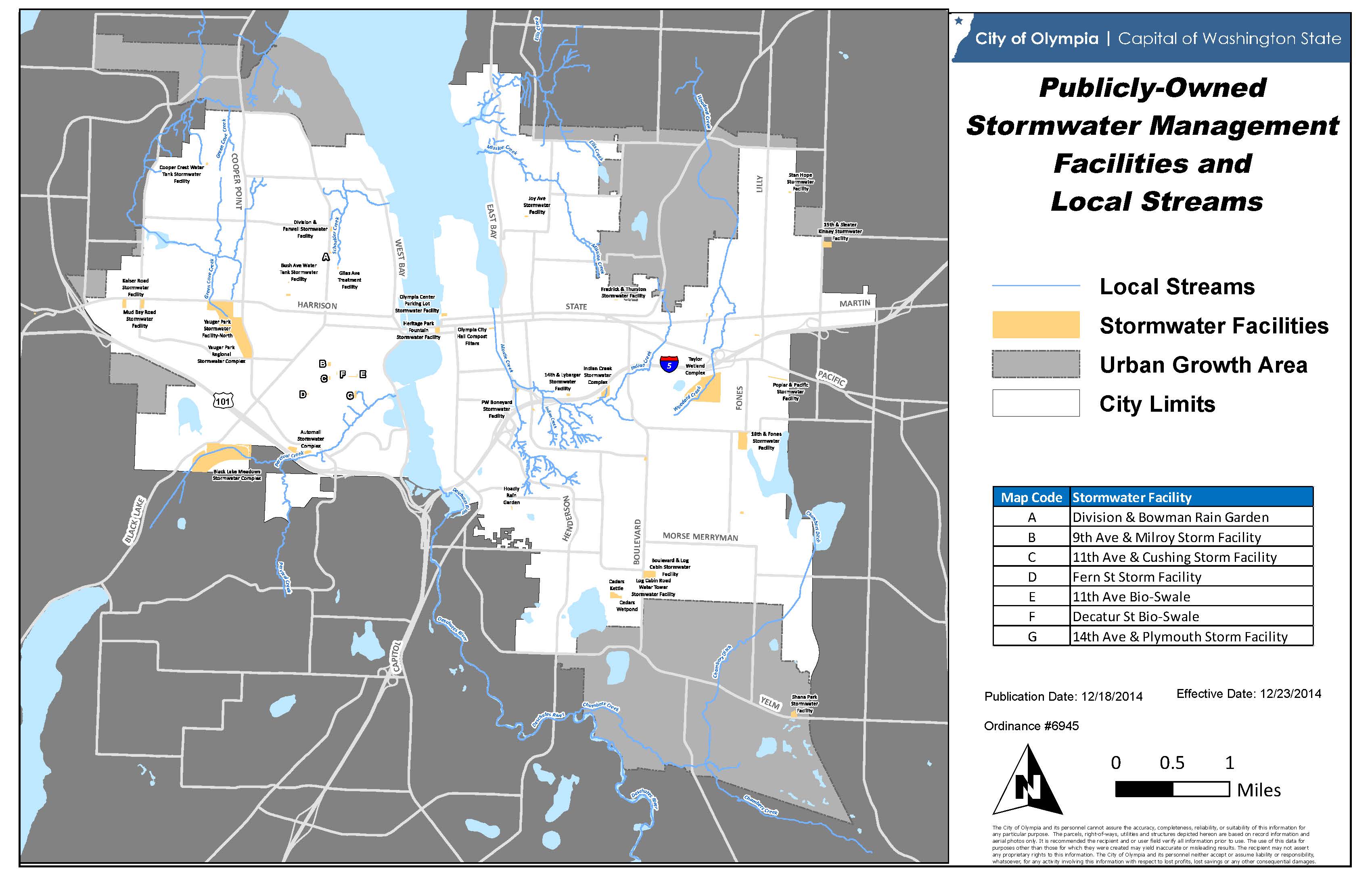
Publicly-Owned Stormwater Management Facilities and Local Streams map
Existing Capacity
For the most part, historical flooding problems have been corrected over the past couple of decades. Now, flooding problems are typically smaller in scale and easier to address than in the past. The Utility manages a pipe televising program to assess the condition of underground infrastructure and to schedule maintenance and repairs before serious problems develop.
Many of the older areas of the City were built before stormwater treatment was required. The Utility looks for opportunities to retrofit stormwater treatment in these areas when feasible.
Future Facilities
Olympia’s Stormwater Drainage Manual requires new development to infiltrate stormwater onsite whenever possible. The need for existing stormwater facility upgrades or repairs is assessed by the Utility annually as part of the Capital Facilities Plan update process.
Waste Resources
Inventory
The Waste ReSources Utility has two core programs: Waste Prevention and Reduction, and Collections. The Waste Prevention and Reduction Program is responsible for preparing and periodically updating the Utility’s waste management plans, and for developing and implementing policies and programs. This program focuses on reducing overall waste and increasing reuse, recycling and composting.
The Collections Program operates the drop-box and curbside collection services, so waste can be disposed of reliably, with minimal impact on environmental and public health and worker safety. In addition to daily residential and commercial collection, the collections staff empties downtown trash containers, removes waste from community events, and cleans up illegal dump sites. They design collection routes, provide onsite technical assistance and customer service, deliver and remove City-owned waste receptacles, and handle billing for drop boxes and commercial dumpsters.
Existing Capacity
The Collections Program serves about 14,000 single-family residential customers, 150 multi-family buildings, and 1,500 commercial customers within the city limits. Single-family residential waste is collected in carts. Olympia’s Waste Resources Collection Area map shows the utility’s current and future service areas. Most waste from multifamily customers is collected in carts or dumpsters, and waste from commercial customers in carts, cans, dumpsters and drop boxes.
The map below shows the regional processing facilities the City uses for our materials. Mixed organic waste (yard debris, food scraps and food-soiled paper) and garbage are delivered by City vehicles to the Waste and Recovery Center (WARC) at Hawks Prairie. Thurston County owns the WARC and contracts with Allied Waste Services for transfer, transport and landfilling of garbage - and for the transfer, hauling and composting of organic waste materials. Currently, co-mingled recyclables are taken to a private transfer station near the County’s WARC, and then to a regional Materials Recovery Facility in Tacoma, Washington.
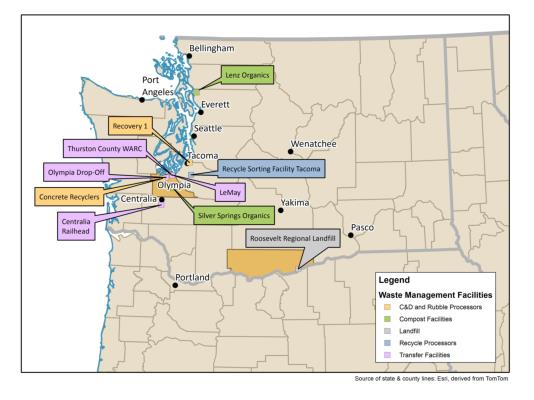
Garbage and non-recyclable construction and demolition debris is compacted into large containers and hauled to a railhead in Centralia. This debris is transported by rail to the Roosevelt Regional Landfill in Klickitat County, which is operated by Rabanco, an Allied Waste subsidiary. Mixed organic waste (yard debris, food scraps and food-soiled paper) is hauled from the WARC to approved composting facilities in the state. Some woody debris and organic waste is taken to industrial sites for burning as hog fuel for energy.
Future Facilities
Future needs for the City’s Waste ReSources (solid waste) Utility will be met by adapting programs to an ever-evolving waste stream while considering disposal, transfer, recycling and composting capacities and technologies. The City depends on both public and private facilities to responsibly manage its waste: Olympia’s garbage is delivered to the county-owned Hawks Prairie transfer station, then hauled to the privately-owned Roosevelt Regional Landfill in Klickitat County. By 2021, Thurston County’s transfer station, paid for by customer fees, may need to expand its capacity. However, landfill capacity at Roosevelt Regional is expected to last another 70 to 80 years.
The City also relies on a private transfer operation to deliver its commingled recycling to a regional sorting facility in Tacoma, Washington. A City-owned and operated transfer site could greatly improve the City’s position in working with recycle sorting facilities and composting operations. The capacity for composting continues to be an issue because of odors and contamination. This has caused the closure of some local options, which means waste must travel further. The capacity for composting and burning organic waste for energy was recently reduced after the closure of two nearby composting operations and a waste-to-energy plant in Grays Harbor. Waste ReSources will need to plan for customer growth as housing density increases and its Urban Growth Areas are annexed.
Description & Inventory of Private Utilities Serving Olympia
Electricity and Natural Gas
Unlike some other private utilities, providers of electricity such as Puget Sound Energy (PSE) must provide electricity upon demand and in accordance with "tariffs" on file with the Washington Utilities and Trade Commission (WUTC). To fulfill its public service obligations, PSE must plan to extend or add to its facilities when needed.
However, this obligation does not apply to the delivery of natural gas, as it is considered a convenience, rather than a necessity, as electricity is. PSE natural gas service is a demand-driven utility and, as such, is prohibited from passing on the cost of new construction to existing customers. Instead, it installs natural gas service for new construction and when customers convert from electricity or oil to natural gas. PSE owns and operates all electrical transmission and distribution stations, as well as the transmission and distribution lines within the City of Olympia. The map below shows existing and proposed major PSE electric and natural gas facilities, but does not show distribution lines.
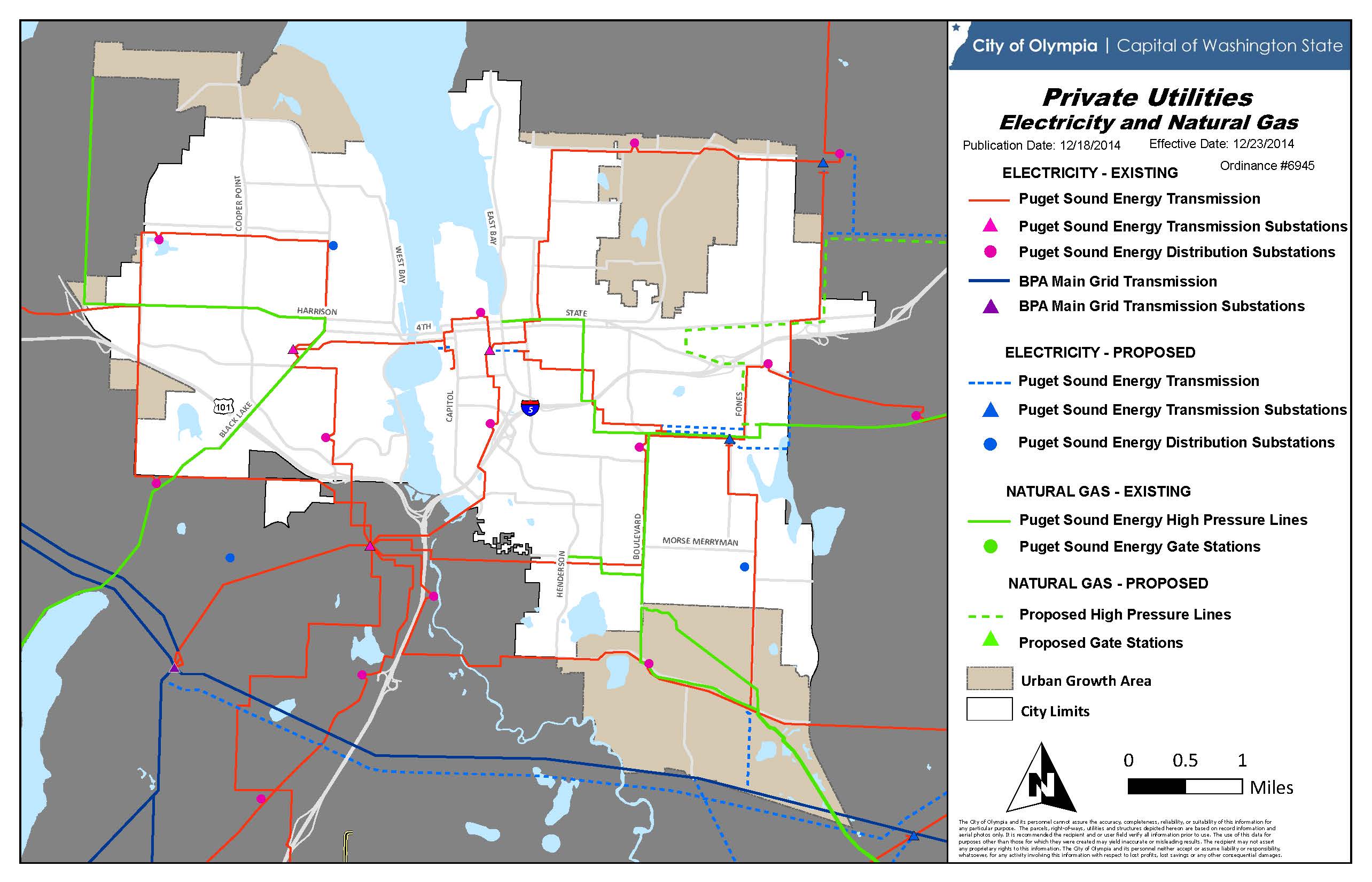
Puget Sound Energy Electric and Natural Gas Facilities
Telecommunications and Cellular Telephone Service
The volatility and competitiveness of the telecommunications market makes it difficult to accurately assess the way future telecommunications will be provided. The Federal Communications Commission (FCC) regulates cellular providers in each cellular geographic service area, and in Olympia and its Urban Growth Area, there are several FCC-licensed providers. In April 2006, the City adopted the Olympia Wireless Telecommunications Master Plan,which includes information about future expansion needs and probable facility locations. The Olympia Municipal Code provides guidance on telecommunications permitting and leasing.
At the state level, cellular telecommunications companies are regulated by the WUTC. Although the technology is increasingly used as a reliable backup communication system during times of emergency, the WUTC defines cellular technology as a utility of convenience, not necessity. Therefore, cellular phone providers are not required to provide service upon demand.
There are several dozen antennas for cellular phone service located in Olympia. The cellular phone system depends on a series of these low-powered antennas in a honeycomb pattern of "cells" that invisibly blanket the service area. Each cell site has a signal radius ranging from a few blocks to a few miles, depending on terrain and capacity.
Standard Telephone Service
As regulated by the WUTC, standard telephone service is considered a necessity. Therefore, CenturyLink Communications International, Inc. (CenturyLink, formerly Quest and AT&T) must provide phone facilities on demand. As communities grow, its facilities are upgraded to ensure adequate service levels and to offer new services.
Standard telephone service has four primary components: central switching offices (two are located in Olympia), main cable routes, branch feeder routes, and local loops. All these components work together to provide a dial tone to every subscriber.
CenturyLink also maintains a broadband telecommunications network over a mix of optical fiber, coaxial cable and copper wire. CenturyLink has said that it plans to continue serving the Olympia area.
Cable Services
Comcast, Inc. is Olympia’s sole cable service provider, and its receiver site also serves surrounding communities. The two key components of the cable system are a receiver site – a tower that picks up air and satellite signals - and a fiber-to-the-node cable system. The cable television system is fed directly by coaxial and fiber-optic cable from the receiver site to Comcast’s Olympia subscribers.
Cities and counties may grant franchises to cable companies that allow them to locate their lines in the public rights-of-way. In exchange, local governments may require cable companies to provide certain services. Olympia’s franchise agreement requires Comcast to:
• Provide service throughout the City, and install the cable underground for all new construction.
• Meet minimum standards for the number of channels provided, variety of programming, quality of customer service, and technical quality of signal transmission.
• Provide a public access studio and facilities that allow programming to originate from a number of public facilities identified by the City.
• Provide free cable service to City buildings.
• Provide financial support for local access television equipment.
Federal law allows local government to charge a franchise fee for use of the Right-of-Way, currently no more than 5% of gross revenue.
In the Olympia area, the “public access studio and facilities” requirement in the franchise is administered by Thurston Community Television (TCTV), a non-profit organization -- on behalf of Olympia, Lacey, Tumwater, and Thurston County. The City has an annual contract with TCTV for specific government, education, and public television access purposes. Comcast leases the TCTV studio to the City for $1 per year and makes an additional cash contribution for local access capital purposes.
Each year, Comcast engineers assess whether it needs to expand its Olympia system so it can continue to provide cable hook-ups to customers as demand rises. At this time, the City is adequately served and expects that will continue for at least the next 20 years.
For More Information
• 1996 North Thurston Coordinated Water System Plan This document outlines the policies and procedures for providing coordinated drinking water services to the North Thurston urban area.
• 1990 General Sewerage Plan for Thurston County This document outlines the plan for providing sewer services to the unincorporated Urban Growth Areas within Thurston County.
• Thurston County’s Hazard Mitigation Plan is a cooperative local government effort to identify and prioritize ways the region can protect itself from its natural vulnerability to hazards such as storms, landslides, earthquakes and flooding.
• Current and past technical analyses and reports regarding sea level rise in Olympia can be reviewed on the City’s Sea Level Rise webpage.


